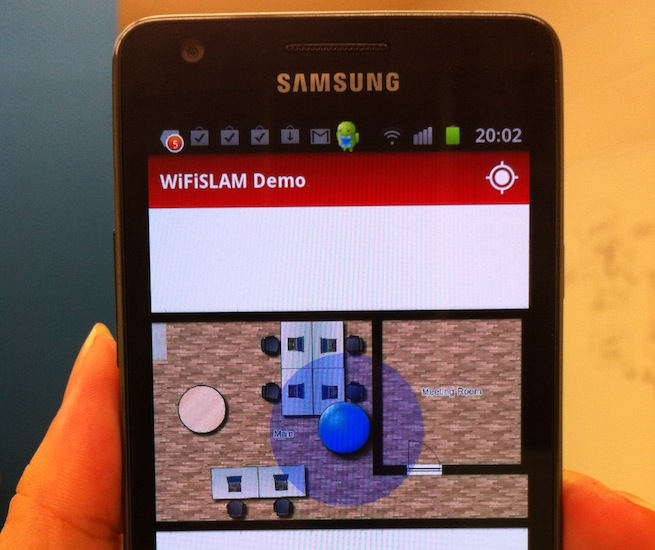
In the race to bring indoor location technology to market, an eight-person startup is taking on big-name players Google, Qualcomm and Samsung. And they have the potential to win.
For the underdogs at Silicon Valley-based WifiSLAM, indoor location services are on the cusp of a second wave. Simply put, services like these aim to do inside what GPS-based navigation does outside. Imagine that you’re in a shopping mall or museum, your smartphone will soon be able to detect your location, within a few meters of accuracy.
If successful, this technology has the potential to impact every industry. “We believe all physical spaces can be as interactive as digital spaces,” said Joseph Huang, WifiSLAM’s cofounder.
Huang isn’t alone in his regard for the space: Indoor location has been getting a lot of renewed interest as of late with companies like Google building dedicated in-house teams. CSR has been demoing the technology for months, and Samsung, Nokia and, Qualcomm recently announced a partnership to invest in and create use cases for indoor location services, which they aim to put in consumer devices by next year.
WifiSLAM is an alumni of Stanford’s tech accelerator “StartX” and has raised a million dollars from a mix of venture capital firms and angel investors, including Google’s Don Dodge and Relay Ventures’ cofounder Kevin Talbot, a mobile computing expert, since incorporating in spring 2011.
WifiSLAM breaks the GPS barrier a little differently than its heavyweight competition, and fellow startups like Finland-based IndoorAtlas (it’s worth checking out — it taps into the magnetic fields that are naturally present in the Earth.) WifiSLAM’s solution uses a combination of Bluetooth and Wi-Fi, and allows for a much finer degree of precision than what’s currently available through “indoor navigation” tools.
 WifiSLAM collects location fingerprints based on the relative strength of Wi-Fi signals as you move through a building and then uses this data to determine your exact position on a map — your “signal signature,” the founders call it.
WifiSLAM collects location fingerprints based on the relative strength of Wi-Fi signals as you move through a building and then uses this data to determine your exact position on a map — your “signal signature,” the founders call it.
The value proposition is that they are marketing directly to application developers, rather than end-users like retailers and merchants. With this strategy, the team has impressed Dodge (pictured left), an angel investor and chief developer relations advocate at Google. Dodge referred the founders to AngelList, and is an outspoken supporter for WifiSLAM. “Building a technology platform requires application developers to succeed,” Dodge told me.

Above: According to Google’s Don Dodge, indoor location is the most exciting opportunity for investors
Dodge, who joined Google in 2009 from Microsoft, mentioned that he is more excited about indoor location technologies than any other space. My inclination is that this will pave the way for some exciting new functionalities in Google Maps. Presumably, the search giant hopes that advertisers will jump at the chance to serve discounts and deals at the exact moment when consumers are contemplating making a purchase. It’s a development that will change the face of advertising.
For Dodge and other high-profile advocates of the space, the potential for the technology is endless. “Imagine being in a supermarket and having your phone guide you exactly to each item on your grocery list,” he said. Using indoor Wi-Fi, “coupons and offers [will be] delivered to your phone based on where you are in the store,” and you’ll know, “exactly where your friends and family members are.” Parents, you’ll be able to locate your kids, assuming you’ve given them smartphones, if they’re ever lost in a shopping mall!
WifiSLAM’s cofounders, Jessica Tsoong, David Millman, Darin Tay (formerly an iOs engineer at Google) and Huang, remain optimistic about their chances despite stiff competition. They reported that their developer base has grown by 250 percent in the last three weeks through word of mouth. The API is free for developers to improve their location-based apps, and it only takes 90 seconds to try out the beta.

Above: Joseph Huang, WifiSLAM’s cofounder
Huang (pictured left), a Stanford computer science grad, said that developers will be responsible for pushing the technology to its limits. The early adopters have already experimented with a variety of use-cases, including audio tours in a museum. The app can pinpoint exactly where a museum-goer is standing, and serve relevant information.
The remaining challenge facing indoor Wi-Fi services is to prove to the public that the technology actually works.
Indoor Wi-Fi was supposed to be the groundbreaking innovation of the previous decade. When it emerged in 2008, tech companies made grandiose claims about hyper-targeted, geo-located advertising, and retailers ate it up. But these early attempts failed to meet expectations.
Despite this, Huang said that in the coming months, there will be thousands of new mobile applications that will take advantage of indoor location “in ways we haven’t thought about.” And with the recent success of geo-location based services like Foursquare and Shopkick, the climate is much more favorable. “At the end of the day,” said Huang. “Indoor location is coming.”

